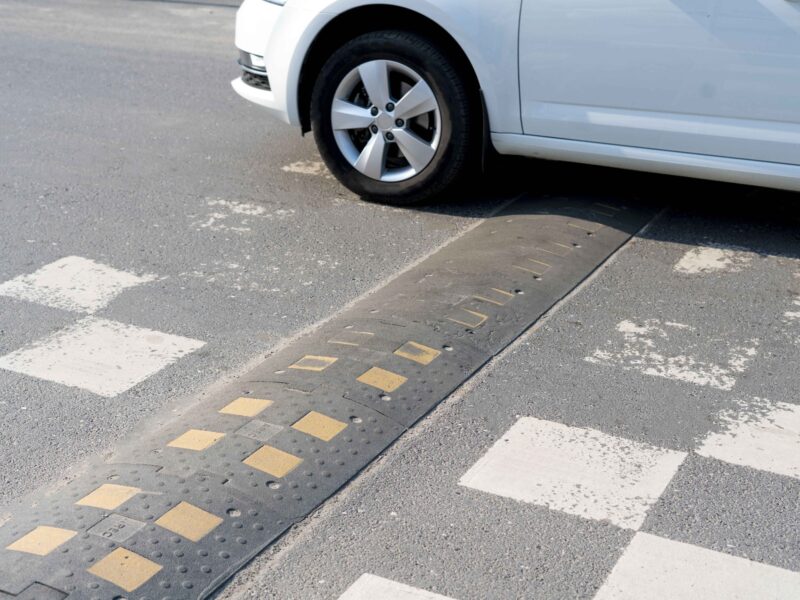
Speed breakers, also known as speed bumps or traffic calming devices, are essential tools in road safety management. They help control vehicle speeds, protect pedestrians, and enhance overall traffic flow. This blog explores the various types of speed breakers, their applications, and how to choose the right solution for different road scenarios.
Understanding Speed Breakers
Speed breakers are raised sections of the road designed to slow down vehicles. They can vary in height, width, and material depending on their intended use. The primary goal is to reduce vehicle speeds in areas where safety is a concern—such as near schools, residential neighborhoods, and commercial zones.
Importance of Speed Breakers
- Enhanced Safety: By reducing vehicle speeds, speed breakers significantly lower the risk of accidents.
- Pedestrian Protection: They create safer environments for pedestrians by encouraging drivers to remain alert.
- Traffic Management: Speed breakers help regulate traffic flow in busy or high-risk areas.
Common Types of Speed Breakers
1. Traditional Speed Bumps
These are solid raised sections made from asphalt or concrete. Typically 3–4 inches high, they reduce vehicle speed to about 15–20 km/h.
Pros:
- Highly effective at speed reduction
- Durable and long-lasting
Cons:
- Uncomfortable at higher speeds
- Not suitable for emergency vehicles
2. Rubber Speed Humps
Made from recycled rubber, these humps are softer and more forgiving on vehicles. They’re easy to install and replace.
Pros:
- Flexible and easy installation
- Less discomfort for vehicles
- Environmentally friendly
Cons:
- May wear down under heavy traffic over time
3. Speed Cushions
Speed cushions are smaller, segmented humps that allow wider vehicles (like buses or trucks) to straddle them while slowing down smaller vehicles.
Pros:
- Ideal for mixed traffic
- Accommodates larger vehicles
Cons:
- May not slow all vehicles equally
4. Speed Tables
These are flat-topped speed humps that span the width of a road and offer a more gradual slope.
Pros:
- Provide a smooth, longer deceleration zone
- Safe for pedestrian crossings
Cons:
- Require more space than traditional bumps
5. Plastic Speed Breakers
Lightweight and modular, plastic speed breakers are ideal for temporary or low-traffic areas. They can be stabilized with sand or water.
Pros:
- Quick to install
- Cost-effective for short-term use
Cons:
- Less durable
- Require frequent replacement in high-traffic zones
6. Rumble Strips
Though not speed breakers in the traditional sense, rumble strips alert drivers through vibrations and sound when they deviate from their lane or approach critical areas.
Pros:
- Excellent warning system
- Easy to install on existing roads
Cons:
- Do not physically reduce vehicle speed
Choosing the Right Speed Breaker
1. Traffic Volume
High-traffic zones may require durable materials like concrete or asphalt. Low-traffic areas can benefit from rubber or plastic options.
2. Vehicle Types
Roads frequently used by larger vehicles should consider speed cushions, which allow smooth passage for wide wheelbases while slowing smaller vehicles.
3. Location and Purpose
- Residential Areas: Traditional bumps work well for calming traffic in neighborhoods.
- School Zones: Speed tables offer safer pedestrian crossings and effective speed control.
- Commercial Areas: Rubber humps manage parking lot traffic and enhance pedestrian safety.
4. Regulatory Compliance
Ensure all speed breakers comply with Indian Road Congress (IRC) and Bureau of Indian Standards (BIS) regulations for safety and legal adherence.
5. Installation and Maintenance
- Timeframe: Rubber and plastic options are faster to install.
- Durability: Concrete lasts longer but may require resurfacing; rubber needs replacement over time.
Practical Applications of Speed Breakers
Residential Areas
Traditional speed bumps slow traffic in narrow streets and protect children and pedestrians.
School Zones
Speed tables near schools provide designated crossing zones and encourage slower vehicle speeds during school hours.
Commercial Areas
Rubber speed humps manage traffic in parking lots and access roads while improving customer safety during high footfall periods.
Highways and Toll Booths
Though not common on highways, speed breakers near toll booths and intersections can manage vehicle speeds where sudden stops are necessary.
Case Studies: Real-World Impact
Mumbai Residential Neighborhood
Authorities installed asphalt speed bumps on narrow lanes, resulting in a noticeable decrease in vehicle speed and improved pedestrian safety during busy hours.
Bangalore School Zone
Speed tables near school entrances created safer crossings for children and improved driver behavior. Parents reported feeling more confident in their children’s safety.
Delhi Shopping District
Rubber speed humps in mall parking lots reduced vehicular speed, enhancing safety and easing pedestrian movement during peak hours.
Conclusion
Choosing the right type of speed breaker is crucial for creating safe, efficient roads that accommodate both vehicles and pedestrians. Each type serves a specific purpose and should be selected based on road conditions, traffic patterns, and vehicle types.
At SKYK, we provide a wide range of high-quality speed breakers and road safety products designed for urban, rural, and commercial environments. Explore our offerings and let us help you enhance road safety with smart, reliable solutions.
